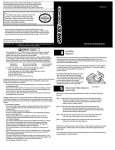Download Lenovo L200P User's Manual
Transcript
L200p Product number 4438-HB6 First Edition (March 2008) © Copyright Lenovo 2008. All rights reserved. LENOVO products, data, computer software, and services have been developed exclusively at private expense and are asold to governmental entities as commercial items as defined by 48 C.F.R. 2.101 with limited and restricted rights to use, reproduction and disclosure. LIMITED AND RESTRICTED RIGHTS NOTICE: IF products, data, computer software, or services are delivered pursuant a General Services Administration "GSA" contract, use, reproduction, or disclosure is subject to restrictions set forth in Contract No. GS-35F-05925. © Copyright Lenovo 2008. i iii Safety and Maintenance Guidelines iv 1-4 1-4 1-4 1-9 Manually installing the Soft OSM 8 3-7 3-9 3AFETY INFORMATION ǰ ¢ ǯ ǰ ³ä ³ǯ 0REDINSTALAC¤TOHOTOPRODUKTUSIPRECTETEPR¤RUCKUBEZPECNOSTN¤CHINSTRUKC¤ ® Ğǰ è Ĵ ǯ Ĵ §§ Ĵǰ ¢ ǯ Ȃ ǰ £ ··ǯ ǯ Ĵǰ £ ££ǯ Ğǯ ǻ¢ Ǽ è Ĵ ǯ ǰ ³ä ³ǯ à ǯ Måt tålfsifutjogpsnbujpofo joobo ev jotubmmfsbs efo iås qspevlufo/ sUmGanBt’manli¥tl¥n; muneBlcab;epIþmbBa©ÚlkmμviFI Ț ¢ ŘŖŖ8. i ii Safety and Maintenance Guidelines iv This User’s Guide contains detailed information on the ThinkVision™ L200p Wide Flat Panel Monitor. For a quick overview, please see the Setup Poster that was shipped with your monitor. Digital Interface Cable Note:To attach a VESA mount, please see “Detaching the monitor stand” on page 2-7. 8 Product overview This section will provide information on adjusting monitor positions, setting user controls, and using the cable lock slot. Types of adjustments Tilt Please see the illustration below for an example of the tilt range. Swivel With the built-in pedestal, you can tilt and swivel the monitor for the most comfortable viewing angle. -45o 45o Height Adjustment After pressing the top of the monitor, remove the fixed pin and adjust the height of the monitor. 110mm 1-2 L200p Wide Flat Panel Monitor User’s Guide Monitor Pivot 90 O - Adjust height to the top position before rotation the monitor. - Rotate clockwise until the monitor stops at 90°. User controls Your monitor has controls on the front which are used to adjust the display. For information on how to use these controls, please see “Adjusting your monitor image” on page 2-3. Chapter 1. Getting started 1-3 Cable lock slot Your monitor is equipped with a cable lock slot located on the rear of your monitor (in the lower right corner). Please follow the instructions that came with the cable lock to attach it. Setting up your monitor This section provides information to help you set up your monitor. Connecting and turning on your monitor Note: Be sure to read the Safety Information located in the Monitor Safety, Troubleshooting, and Warranty Guide before carrying out this procedure. 1. Power off your computer and all attached devices, and unplug the computer power cord. 2. Connect the digital signal cable to the video port on the back of the computer. Note: One end of the signal cable is already pre-attached to your monitor. 1-4 L200p Wide Flat Panel Monitor User’s Guide 3. Connect the analog signal cable to the D-SUB connector of the monitor and the other end on the back of the computer. 4. Plug the monitor power cord and the computer cord into grounded electrical outlets. Note: A certified power supply cord has to be used with this equipment. The relevant national installation and/or equipment regulations shall be considered. A certified power supply cord not lighter than ordinary polyvinyl chloride flexible cord according to IEC 60227 (designation H05VV-F 3G 0.75mm2 or H05VVH2-F2 3G 0.75mm 2) shall be used. Alternative a flexible cord be of synthetic rubber according to IEC 60245 (designation H05RR-F 3G 0.75mm2) shall be used. Chapter 1. Getting started 1-5 5. Remove the Cable Cover from the back of the stand. 2 1 6. Rotate the head of the monitor into portrait view. 1-6 L200p Wide Flat Panel Monitor User’s Guide 7. Place the cables through the Main Clip. Then fasten the clip. 8. Wrap the Cable Wapper around the cables. 9. Rotate the Hook. Chapter 1. Getting started 1-7 10. Replace the Cable Cover. 2 1 11. Power on the monitor and the computer. 12. To install the monitor driver, insert the Reference and Driver CD, click Install driver, and follow the on-screen instructions. 1-8 L200p Wide Flat Panel Monitor User’s Guide 13. To optimize your monitor image, if using the analog cable, press the Automatic Image Setup key. Automatic image setup requires that the monitor is warmed up for at least 15 minutes. This is not required if you are using the DVI cable. Note: If automatic image setup does not establish the image that you prefer, perform manual image setup. See “Manual image setup” on page 3-2 Registering your option Thank you for purchasing this Lenovo™ product. Please take a few moments to register your product and provide us with information that will help Lenovo to better serve you in the future. Your feedback is valuable to us in developing products and services that are important to you, as well as in developing better ways to communicate with you. Register your option on the following Web site: http://www.lenovo.com/register Lenovo will send you information and updates on your registered product unless you indicate on the Web site questionnaire that you do not want to receive further information. Chapter 1. Getting started 1-9 ft tt lenovo. ft tt 8 tt ft ft v Use adequate lighting for the type of work you are performing. v Use the monitor brightness, contrast, and image adjustment controls, if equipped, to optimize the image on your screen to meet your visual preferences. v Keep your monitor screen clean so you can focus on the screen’s contents. Any concentrated and sustained visual activity can be tiring for your eyes. Be sure to periodically look away from your monitor screen and focus on a far object to allow your eye muscles to relax. If you have questions on eye fatigue or visual discomfort, consult a vision care specialist for advice. Quick tips for healthy work habits The following information is a summary of some important factors to consider to help you remain comfortable and productive while you use your computer. v Good posture starts with equipment setup: The layout of your work area and the setup of your computer equipment have a large effect on your posture while using your computer. Be sure to optimize the position and orientation of your equipment by following the tips outlined in “Arranging your work area” on page 2-1 so you can maintain a comfortable and productive posture. Also, be sure to use the adjustment capabilities of your computer components and office furniture to best suit your preferences now and as your preferences change over time. v Minor changes in posture can help avoid discomfort: The longer you sit and work with your computer, the more important it is to observe your working posture. Avoid assuming any one posture for an extended period of time. Periodically make minor modifications in your posture to help deter any discomforts that might arise. Make use of any adjustments that your office furniture or equipment provide to accommodate changes in posture v Short, periodic breaks help ensure healthy computing: Because computing is primarily a static activity, it is particularly important to take short breaks from your work. Periodically, stand up from your work area, stretch, walk for a drink of water, or otherwise take a short break from using your computer. A short break from work gives your body a welcome change in posture and helps to ensure you remain comfortable and productive while you do work. Accessibility information Lenovo is committed to providing greater access to information and technology to people with disabilities. With assistive technologies, users can access information in the way most appropriate to their disability. Some of these technologies are already provided in your operating system; others can be purchased through vendors or accessed at: http://www.ibm.com/able/ http://www-03.ibm.com/research/accessibility/requests/accvpat.nsf/lenovo-bidx?OpenForm 2-2 L200p WidePanel Flat Panel Monitor User’s Guide Monitor User’s Guide L194 Flat Adjusting your monitor image This section describes the user control features used to adjust your monitor image. Using the direct access controls The direct access controls can be used when the On Screen Display (OSD) is not displayed. Note: The direct access controls are blue. Table 2-1. Direct access controls Icon Control Description Input Change Switches the video input source. Image Setup Activates automatic image adjustment. Brightness Direct access to Brightness adjustment. Using the On-Screen Display (OSD) controls The settings adjustable with the user controls are viewed through the On-Screen Display (OSD), as shown below. To use the controls: 1. Press to open the main OSD menu. 2. Use or to move among the icons. Select an icon and press to access that function. If there is a sub-menu, you can move between options using or , then press to select that function. Use or to make adjustments. Press to save. to move backwards through the sub-menus and exit from the OSD. 3. Press for 10 seconds to lock the OSD. This will prevent accidental 4. Press and hold for 10 seconds to unlock the OSD adjustments to the OSD. Press and hold and allow adjustments to the OSD. 5. Enables DDC/CI by default. Use OSD Exit Key,Press and hold the buttons for 10 seconds to disable / enable DDC/CI function. The words " DDC/CI Disable/DDC/ CI/Enable" shows on the screen. Chapter 2. Adjusting and using your monitor 2-3 Table 2-2. OSD functions OSD Icon on Main Menu Brightness/ Contrast Submenu Brightness Contrast Image Position Horizontal Position Vertical Position Image Setup Automatic Manual Image Properties Color Description Controls and Adjustments (Analog) Adjusts overall brightness 2-4 Flat Panel Monitor User’s Guide L20094 L200p Wide Flat Panel Monitor User’s Guide Same as Analog Adjusts difference between light and dark areas Moves the image left or right. Controls Locked not required for digital input Moves the image up or down. Automatically optimizes the image. Manually optimizes the image. See “Manual image 3-3 setup” on page 3-4. • • Clock Phase • Save Adjusts intensity of red, green, and blue. Preset mode • Neutral Default • sRGB • Reddish • Bluish Custom Scaling Controls and Adjustments (Digital) • Red: Increases or decreases the saturation of ’red’ in the image. • Green: Increases or decreases the saturation of ’green’ in the image. • Blue: Increases or decreases the saturation of ’blue’ in the image. • Save: Saves the custom color choices. • off native (1:1) • on expand the image to full screen Same as Analog Table 2-2. OSD functions OSD Icon on Main Menu Submenu Input signal Description Controls and Adjustments (Analog) This monitor can accept video signals through two different connectors. Most desktop computers use a D-SUB connector. Select digital among OSD Controls when you use DVI connector. Controls and Adjustments (Digital) Same as Analog - Selects D-SUB (Analog) - Selects DVI-Digital Options Information Menu Language Menu Position Shows resolution, refresh rate, and product details. Note:: This screen does not allow any changes to the settings. This section lists the languages supported by your monitor. Note:: The language chosen only affects the language of the OSD. It has no effect on any software running on the computer. Menu position adjusts menu location on the screen. Default: Returns the menu position to the default settings. Custom: • • • Reset Accessibility Same as Analog Same as Analog Horizontal: Changes the horizontal position of the OSD. Vertical: Changes the vertical position of the OSD. Save • Cancel • Reset Resets monitor to the original factory settings. Controls button and menu settings for accessibility preferences. Button repeat rate: Select or to change. • Off • Default • Slow Menu time out: Sets the length of time the OSD will remain active after the last time a button is pressed. Exit Exit the main menu Same as Analog Chapter 2. Adjusting and using your monitor 2-5 Selecting a supported display mode The display mode the monitor uses is controlled by the computer. Therefore, refer to your computer documentation for details on how to change display modes. The image size, position and shape might change when the display mode changes. This is normal and the image can be readjusted using automatic image setup and the image controls. Unlike CRT monitors, which require a high refresh rate to minimize flicker, LCD or Flat Panel technology is inherently flicker-free. Note: If your system has previously been used with a CRT monitor and is currently configured to a display mode outside the range of this monitor, you may need to re-attach the CRT monitor temporarily until you have re-configured the system; preferably to 1680x1050 at 60 Hz, which is the Native Resolution Display mode. The display modes shown below have been optimized at the factory. Table 2-3. Factory set display modes Addressability 640x480 Refersh rate 60Hz, 66Hz, 72Hz, 75Hz 720x400 720x400 800x600 800x600 70Hz 70Hz 60Hz, 72Hz, 72Hz, 75Hz 75Hz 60Hz, 1440x900 60Hz, 75Hz 1680x1050 60Hz, 75Hz 60Hz, 70Hz, 75Hz 60Hz, 70Hz, 75Hz 75Hz 75Hz 60Hz 60Hz, 60Hz, 72Hz, 72Hz, 75Hz 75Hz 1024x768 1024x768 1152x864 1152x864 1280x768 1280x1024 1280x1024 Understanding power management Power management is invoked when the computer recognizes that you have not used your mouse or keyboard for a user-definable period. There are several states as described in the table below. For optimal performance, switch off your monitor at the end of each working day, or whenever you expect to leave it unused for long periods during the day. Table 2-4. Power indicator 2-6 State On Standby/ Supsend Power Indicator Steady green Steady amber Screen Normal Blank Off Off Off L200p Wide Flat Panel Monitor Guide Panel Monitor UserUser’s s Guide L194 Flat Restoring Operation Compliance Press a key or move the mouse. There may be a slight delay reappears. Note: Standby also occurs if there is no image output to the monitor. Press a key or move the mouse. There may be a slight delay before the image reappears. ENERGY STAR ENERGY STAR Image rotation Before rotating the monitor, you should set-up your computer to rotate the image. Rotating the image may require special rotation software or you may find that your computer is preloaded with video graphic drivers that allows image rotation. Check the Graphic Properties setting on your computer to see if this feature is available. Try these steps to check if image rotation is available on your computer. 1. Right-click on the desktop and click Properties. 2. Select the Settings tab and click Advanced. 3. If you have ATI, select the Rotation tab and set the preferred rotation. If you have nVidia, click the nVidia tab, in the left-hand column select NVRotate, and then select the preferred rotation. If you have Intel, select the Intel graphics tab, click Graphic Properties, select the Rotation tab, and then set the preferred rotation. Check with the manufacturer of your computer to see if graphic drivers with image rotation can be downloaded from their support website. Caring for your monitor Be sure to turn off the power before you perform any maintenance on the monitor. Do not: Apply water or liquid directly to your monitor. Use solvents or abrasives. Use flammable cleaning materials to clean your monitor or any other electrical equipment. Touch the screen area of your monitor with sharp or abrasive items. This type of contact may cause permanent damage to your screen. Use any cleaner which contains an anti-static solution or similar additives. This may harm the coating of the screen area. . . . . . Do: Lightly dampen a soft cloth with water and use this to gently wipe the covers and the screen. Remove grease or finger marks with a damp cloth and a little mild detergent. . . Detaching the monitor stand After placing the monitor face down on a clean surface or soft cloth, remove the four screws from the stand to remove it from the monitor. Chapter 2. Adjusting and using your monitor 2-7 4438-Hx6 366.5 mm (14.43 in.) 244.7 mm ( 9.63 in.) 471.0 mm (18.54 in.) Range: 0 Swivel Range: -45 , +45 Lift Range: 110.0mm Pivot Yes (clock wise 90 degree) 433.44 mm (17.06 in.) 270.90 mm (10.67 in.) 433.44 mm (17.06 in.) 58 100-240 42 Video input (Analog) Video input (Digital) Altitude Test Input signal Analog Direct Drive, 75 ohm 0.7 V Horizontal addressability 1680 pixels (max) Vertical addressability 1050 lines (max) Clock frequency 190 Interface DVI Input Signal VESA TMDS (Panel Link™) Horizontal addressability 1680 pixels (max) Vertical addressability 1050 lines (max) Clock frequency 150 Operation MHz MHz 8,000 ft VAG: DVI: 0 5 1680 1050 40 8. 83 83 32 104 Table 3-1. Monitor specifications for type-model 4434-Hx6(continued) Humidity Operating 10% to 80% Storage 5% to 95% Shipping 5% to 95% Troubleshooting If you have a problem setting up or using your monitor, you might be able to solve it yourself. Before calling your dealer or Lenovo, try the suggested actions that are appropriate to your problem. Table 3-2. Troubleshooting Problem Possible cause Suggested action Reference The words ″Out of Range″ are shown on the screen, and the power indicator is flashing green. The system is set v If you are replacing an “Selecting a supported to a display old monitor, reconnect display mode” on page 2-5 mode which is it and adjust the not supported by display mode to within the monitor. the specified range for your new monitor. v If using a Windows system, restart the system in safe mode, then select a supported display mode for your computer. v If these options do not work, contact the Customer Support Center. The image quality is unnacceptable. The video signal cable is not connected with the monitor or system completely. Be sure the signal cable is “Connecting and turning firmly plugged into the on your monitor” on system and monitor. page 1-3 The color settings may be incorrect. Select another color setting from the OSD menu. The automatic Perform automatic image image setup setup. function was not performed. The power indictator is not lit and there is no image. v The monitor’s power switch is not switched on. v The power cord is loose or disconnected. v There is no power at the outlet. 3-2 L194 Flat Panel Monitor User’s Guide L200p Wide Flat Panel Monitor User’s Guide L194Wide Flat Panel Monitor User’s Guide “Adjusting your monitor image” on page 2-3 “Adjusting your monitor image” on page 2-3 v Be sure the power cord “Connecting and turning on your monitor” on is connected properly. page 1-3 v Be sure the outlet has power. v Power on the monitor. v Try using another power cord. v Try using another electrical outlet. Table 3-2. Troubleshooting (continued) Problem Possible cause Suggested action Reference Screen is blank and power indicator is steady amber or flashing green The monitor is in v Press any key on the Standby/Suspend keyboard or move the mode mouse to restore operation. The power indicator is green, but there is no image. The video signal cable is loose or disconnected from the system or monitor. Be sure the video cable is connected with the system properly. The monitor brightness and contrast are at the lowest setting. Adjust the brightness and “Adjusting your monitor contrast setting on the image” on page 2-3 OSD menu. “Understanding power management” on page 2-6 v Check the Power Options settings on your computer. One or more of This is a the pixels appear characteristic of discolored the LCD technology and is not an LCD defect. v Fuzzy lines in text or a blurry image. v Image setup has not been optimized v Horizontal or vertical lines through the image. v Your system Display Properties setting have not been optimized. “Connecting and turning on your monitor” on page 1-3 If there are more than five pixels missing, contact the Customer Support Center. Appendix A, “Service and Support,” on page A-1 Adjust the resolution settings on your system to match the native resolution for this monitor: 1440 x 900 at 60 Hz. “Adjusting your monitor image” on page 2-3 Perform automatic image setup. If automatic image setup does not help, perform manual image setup. “Selecting a supported display mode” on page 2-5 When working in the native resolution, you may find additional improvements by adjusting the Dots Per Inch (DPI) setting on your system. See the Advanced section of your system’s display properties. “Manual image setup” Manual image setup If automatic image setup does not establish the image that you prefer, perform manual image setup. Note: Have your monitor powered on for about 15 minutes, until the monitor warms up. at the bottom of the monitor to open the OSD menu. 1. Press 2. Use 3. Use or or to select and press to access. to select Clock and Phase adjustment. Chapter 3. Reference information 3-3 f th ft Manually installing the monitor driver Below are steps for manually installing the monitor driver in Microsoft Windows Vista, Microsoft. Windows XP. And Microsoft Windows 2000 Professional. Installing the monitor driver in Windows Vista To install the device driver in Microsoft® Windows Vista, do the following: Note: You must download files from the Lenovo Monitor CD to use the Plug and Play feature in Windows Vista. 1. Turn off the computer and all attached devices. 2. Ensure that the monitor is connected correctly. 3. Turn on the monitor and then the system unit. Allow your computer to start the Windows Vista operating system. 4. Open the Display Properties window by clicking Start, Control Panel and then double-clicking the Hardware and Sound icon. 5. Click the Personalization icon. 6. Click the Display Settings icon. 7. Click the Advanced Settings button. 8. Click the Monitor tab. 9. Click the Properties button. 10. Click the Driver tab. 11. Open the "Update Driver Software-Generic PnP Monitor " window by clicking on Update Driver and then click the "Browse my computer for driver sfotware" button . 12. Select “Let me pick from a list of device drivers on my computer ” and then click the Next button. 13. Insert the Lenovo Monitor CD into the CD drive and click the Have Disk button. Click on the Browse button and navigate to the following directory: X:\Monitor Drivers\Windows Vista (whereX is the drive letter designator for the CD-ROM drive). 14. Select the " L200pwD.inf" file and click the Open button. Click the OK button. 15. Select L200pwD and click Next . The files will be copied from the CD to your hard disk drive. 16. Close all open windows and remove the CD. . 17. Restart the computer. The system will automatically select the maximum refresh rate and corresponding Color Matching Profiles. Note: On LCD monitors, unlike CRTs, a faster refresh rate does not improve display quality. Lenovo recommends using either 1680 x 1050 at a refresh rate of 60 Hz, or 640 x 480 at a refresh rate of 60 Hz. 3-4 L200p Wide Flat Panel Monitor User’s Guide Flat Flat Panel Monitor User’s Guide L194Wide L194 Panel Monitor User’s Guide Installing the monitor driver in Windows XP To use the Plug and Play feature in Windows XP, files should be loaded from the Reference and Driver CD. Note: This section must be completed before continuing with the Windows XP automatic image setup. 2. Ensure tha� he monitor is connected correctly. 3. Turn on the monitor and then the system unit. Allow the system to boot into Windows XP. 4. Open the Display Properties window by clicking Panel, and then double-clicking the Display icon. 5. Click the tab. 6. Click the Advanced 7. 8. 9. 10. Click the Monitor tab. Click the Properties Click the Drivers tab. Open the Hardware Update Wizard window by clicking on Update Driver, and then click Next. 11. Select Install from a list or Specific location(Advanced), and then click Next. 13. Click on the Browse button and navigate to the following directory: X:\Monitor Drivers\Windows XP & Windows 2000 (whereX is the drive letter designator for the CD-ROM drive). 14. Select the "L200pwD.inf " file and click the Open button. Click the OK button. 15. Choose L200pwD and click OK. The files will be copied from the CD to your hard disk drive. 16. Close all open windows and remove the CD. 17. Restart the system. The system will automatically select the maximum refresh rate and corresponding Color Matching Profiles. Note: On LCD monitors, unlike CRTs, a faster refresh rate does not improve display quality. Lenovo recommends using either 1680 x 1050 at a refresh rate of 60 Hz, or 640 x 480 at a refresh rate of 60 Hz. Chapter 3. Reference information 3-5 Installing the monitor driver in Windows 2000 To use the Plug and Play feature in Windows 2000, files should be loaded from the Reference and Driver CD. Click on the Browse button and navigate to the following directory: X:\Monitor Drivers\Windows XP & Windows 2000 (whereX is the drive letter designator for the CD-ROM drive). Select the "L200pwD.inf " file and click the Open button. Click the OK button. 200pwD 68 3-6 L200p Wide Flat Panel Monitor L194 Flat Panel Monitor User’sUser’s GuideGuide 1050 Manually installing the Soft OSM Below are steps for manually installing the Soft OSM. 1. Insert Lenovo Monitor CD into the CD drive. The CD menu displays. Select “Install Soft OSM” and follow the on-screen instructions. Or you can navigate to the following directory to find Soft OSM setup program: X:\Soft OSM Drivers (whereX is the drive letter designator for the CD-ROM drive). 2. This is aLicenses Agreement dialog box, select and click Next . 3. Select a directory for Soft OSM installation or keep the default directory, click Start to install. Chapter 3. Reference information 3-7 3-8 4. It will take several seconds to copy the files to your computer. 5. When the View Readme File dialog box appears , click OK. 6. Restart your computer. 7. After the computer has started up, you can see a monitor icon in the lower right hand corner of the desktop.Double clickthe icon, you can use Soft OSM to do adjusting right now. L200p Wide Flat Panel Monitor User’s Guide tt Service and Support, Service information Product numbers The product number for your monitor is located on the side of the display bezel as shown below. Customer responsibilities The warranty does not apply to a product which has been damaged due to accident, misuse, abuse, improper installation, usage not in accordance with product specifications and instructions, natural or personal disaster, or unauthorized alterations, repairs or modifications. The following are examples of misuse or abuse and not covered by warranty: . Images burned onto the screen of a CRT monitor. Burned image is preventable by utilizing a moving screen saver or power management. . Physical damage to covers, bezel, base and cables. . Scratches or punctures on monitor screens. Chapter 3. Reference information 3-9 4438-Hx6 L200p Wide FRU Monitor Lenovo Business Black 4438-HB6 43R1951 L200p Wide FRU Signal cable(Analog, 2.2m) Business Black 4438-HB6 43R1952 L200p Wide FRU Signal cable(Digital, 2.2m) Business Black 4438-HB6 L200p Wide FRU Stand and base Business Black 4438-HB6 43R1950 43R1953 3-10 L200p Flat Panel Monitor User’s Guide Flat Panel Monitor User’s Guide L194Wide 8 Country or Region Telephone Number Africa Africa: +44 (0)1475-555-055 South Africa: +27-11-3028888 and 0800110756 Central Africa: Contact the nearest Lenovo service provider Argentina 0800-288-5366 (Spanish) Australia 131-426 (English) Austria Up and running support: 01-24592-5901 Warranty service and support: 01211-454-610 (German) Belgium Up and running support: 02-210-9820 (Dutch) Up and running support: 02210-9800 (French) Warranty service and support: 02-225-3611 (Dutch, French) Bolivia 0800-0189 (Spanish) Brazil Sao Paulo region: (11) 3889-8986 Outside Sao Paulo region: 0800-701-4815 (Brazilian Portuguese) Canada Toronto: 416-383-3344 Outside Toronto: 1-800-565-3344 (English, French) Chile Toll Free: 1230-020-1130 (Spanish) China 800-810-1818 ext 5070 8610 84981188 ext 5070 (Mandarin) China (Hong Kong S.A.R.) Home computer: 852-2825-7799 Commercial computer: 852-8205-0333 ThinkPad and WorkPad: 852-2825-6580 (Cantonese, English, Mandarin) Colombia 01-800-952-0466 (Spanish) Costa Rica 800-011-1029 (Spanish) Croatia 0800-0426 Cyprus +357-22-841100 Czech Republic +420-2-7213-1316 Denmark Up and running support: 4520-8200 Warranty service and support: 7010-5150 (Danish) Dominican Republic Toll Free: 1-866-434-2080 (Spanish) Ecuador 1-800-426911 (Spanish) El Salvador 800-6264 (Spanish) Estonia +386-61-1796-699 Finland Up and running support: 09-459-6960 Warranty service and support: +358800-1-4260 (Finnish) France Up and running support: 0238-557-450 Warranty service and support (hardware): 0810-631-213 Warranty service and support (software): 0810-631020 (French) Germany Up and running support: 07032-15-49201 Warranty service and support: 01805-25-35-58 (German) Greece +30-210-680-1700 Guatemala 1800-624-0051 (Spanish) Honduras Tegucigalpa: 232-4222 San Pedro Sula: 552-2234 (Spanish) Hungary +36-1-382-5720 India 1800-425-6666 +91-80-2678-8970 (English) Indonesia 800-140-3555 (English) 62-21-251-2955 (Bahasa, Indonesian) Ireland Up and running support: 01-815-9202 Warranty service and support: 01-8811444 (English) A-2 L200p Wide FlatPanel Panel Monitor User’s Guide L194 Flat Monitor User’s Guide Flat Panel Monitor User’s Guide L194Wide Appendix A. Service and Support A-3 Country or Region Telephone Number Turkey 00800-4463-2041 (Turkish) United Kingdom Up and running support: 01475-555-055 Warranty support: 08705-500-900 (English) United States 1-800-426-7378 (English) Uruguay 000-411-005-6649 (Spanish) Venezuela 0-800-100-5722 (Spanish) Vietnam For northern area and Hanoi: 84-4-843-6675 For southern area and Ho Chi Minh City: 84-8-829-5160 (English, Vietnamese) A-4 L200p Wide Flat Panel Monitor User’s Guide L194 Flat Panel Monitor User’s Guide L194Wide Flat Panel Monitor User’s Guide !PPENDIX " .OTICES ¢ ě ǰ ǰ ǯ ¢ ¢ ¢ ǯ ¢ ǰ ǰ ¢ ¢ ǰ ǰ ¢ ǯ ¢ ¢ ǰ ǰ ¢ ¢ ¢ ǯ ǰ Ȃ ¢ ¢ ¢ ǰ ǰ ǯ ¢ Ĵ ǯ Ğ ¢ ¢ ǯ ǰ ǰ DZ ǻ Ǽǰ ǯ śŖŖ Ĝ ǰ ¢ǯ śŚ ǰ ŘŝŝŖş ǯǯǯ ĴDZ ǯ ȃ Ȅ ǰ ǰ ǰ ǰ Ȭǰ ǯ ¡ ǰ ǰ ¢ ¢ ¢ǯ ¢ ǯ ¢ Dz Ğ ǯ ¢ Ȧ ǻǼ Ȧ ǻǼ ¢ ǯ ¢ ¢ ǯ ě ę ǯ ¡ ¢ ¢ ǯ ę ǯ ¢ ¢ǯ ¢ ¢ Ğ ¢ ¢ ¢ ¢ ¢ ¢ǯ ¢ Ȭ ¢ ¢ Ğ ǯ Ĵ Ğ ǰ Ğ ¢ ǯ ¢ ǯ ǰ ¢ Ț ¢ ŘŖŖ8ǯ Ȭŗ ¢ ę¢ǯ ¢ Ȭ ¢ Ĵ ¢ ¢ǯ ǰ ¢ ¡ǯ ¢ ¢ǯ Ğ ¢ ę ǯ 4RADEMARKS ǰ ǰ DZ ǯ Ğǰ ǰ Ğ ǰ ǰ ǯ ¢ǰ ǰ ¢ ǯ ȬŘ L200p Wide Flat Panel Monitor User’s Guide L194Wide Flat Ȃ L194 Panel Monitor User’s Guide
















































